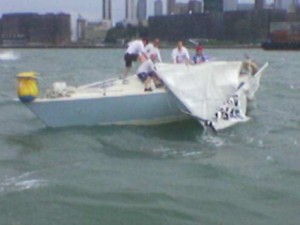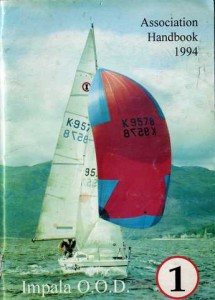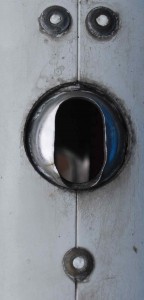Yacht masts are remarkably durable items — given good support, proper handling and caring routine maintenance, they will last 20 years or so.
There are two basic structural requirements when holding up masts with stays:
1. To keep the mast reasonably straight athwartshlps, and within fore & aft bend limits (in column). It is a strut, and will only maintain its compressive strength within certain bend limits. This is readily demonstrated by the classic drinking straw test. lf you hold it vertically then press down on the top, it will resist the compression quite well – even when it begins to bow. Once the degree of bow reaches a critical
point, the straw buckles and fails by bending. On a yacht mast, the degree of bend can be controlled within limits by suitable rig geometry and sensible handling.
2. To prevent undue consumption of fatigue life. All structures that operate with cyclic loadings can eventually fail. A yacht’s rig is a combination of interactive components with differing characteristics – all of which conform to the general fatigue life pattern. Fatigue failure can result from a small number of high loadings, a great number of low loadings, or a non linear combination of the two. The high load/low cycles case is easy to avoid – just use adequate rigging tensions. In a seaway, if the rig is too slack, the mast head or spreader area can build up movement. As the mast reaches the end of its travel, the shock loading on the stay is enormous. Operating this way can ruin stays in a very short period. The Old Sages who advise slack rigging are not analysing the problem!
 Over-tensioned rigging also has its drawbacks. It will eliminate the shock loadings induced in slack rigs, but the higher total loads can also shorten its life.
Over-tensioned rigging also has its drawbacks. It will eliminate the shock loadings induced in slack rigs, but the higher total loads can also shorten its life.
Stainless steel wire is subject to a steady consumption of its fatigue life due to the cyclic variations in loading when sailing and at rest. Stainless steel, given adequate contact with oxygen, does not rust & therfore does not usually give highly visible advance notice of failure. The most likely indication is a single strand broken at the point where the wire enters the terminal – but if a core strand fails first, then this warning signal will be concealed. Stainless steel running rigging which has developed `spikes’ has almost certainly reached the end of its fatigue life and is soon likely to fail.
The area of greatest concem is not the wire itself- it is very rare for a length of wire to fail in the middle – unless it has been subject to surface damage, the problem is at the end fittings (terminals). The requirement is for the temrinal to grasp hold of the wire without compromising its strength characteristics, allow for a smooth transfer of load and provide for a fair and articulating connection at the mast and chain plate.
The most common method of `grasping’ the wire is the roll swage. The wire is inserted into the long tubular end of the `terminal’ which in the case of modern swaging machines is drawn through a pair of identical passive rollers which have semi-circular grooves on their circumference. When swaged correctly with a swaging machine in good condition the terminal is reduced to the correct diameter without bending or deforming the material with the minimum number of passes, multiple passes required by old type powered roller machines to straighten & reduce the terminal to the correct size (causing work hardening & embrittlement of the terminal) are not necessary — the completed `swage’ is straight and free from cracks. The terminal is forced onto the wire so well that if cut through, the cross section resembles a solid bar. Bent, cracked or misshaped terminals found during an inspection should be treated with suspicion.
On rigs like the Impala which use T Bar terminals for attaching the shrouds it is essential to use the correct type of ‘T’ terminal to match the backing plate in the mast thereby allowing full articulation of the terminal.
With the exception of Holts & some foreign mast manufacturers these can usually be split into two types-
a. The `Norseman Gibb’ type – identifiable by its elongated slot with rounded ends, used by Proctor Masts.
b. The `Hasselfors’ type – identitible by its round backplate with elongated slot, used on Kemp Masts, most commonly found on lmpaIa‘s.
Latterly T bar terminals are been replaced on 6mm wires by shroud terminals. A spoon shaped end that locates in a slightly protruding hemispherical backing plate. This is a recent design (1989) that has been extensively fatigue tested & is specially suited for use with DYFORM type wires.
Whichever type is used, it is absolutely essential that the terminal has not only adequate articulation but must also allow the swaged section to align with the wire, it may be necessary to adjust the body of the swage (a once only proceedure) by bending in a vice to obtain correct alignment. Failure to achieve this may reduce the fatigue life of the stay & its backing plate, leading to premature failure.
The lower end of the stay – the turnbuckle, should include a toggle that allows fore & aft & athwartships articulation – toggles should be fitted to all sail carrying stays, strip metal chain plates should be formed to match the individual shroud angle.
Providing that the stay/termination combinations are correct, & treated properly, the rigging should have a reasonable lifespan. The operative word is properly. The rig designer assumes that the rigging will be adjusted correctly. Adjustment rather than Tuning is the point in question, this being the normal requirements as opposed to some way out method of finely honing the yacht’s racing performance.
There are numerous `expert’ adjustment methods propounded in the yachting press, each with its own ‘wrinkles. None are likely to lead the Owner astray, if nothing else they will induce him to watch his rig. There is nothing more instructive when sailing than looking up the mast track from deck level & also checking the lee rigging.
So, assuming that the rig is properly designed, the rigging correctly manufactured, & the proper initial adjustments made, what is left for the Owner to do’?
He must be aware of the limitations that apply to his rig. These concern the recommended rigging tensions & the maximum operating bend. This information should be available from the Builder or Mast maker.
He must observe his rig in action, & be prepared to readjust his rigging accordingly. With new rigging, there will be an initial stretch as the strands bed-in, this also applies to DYFORM which will does have an initial stretch caused by the bedding in of the wires, the stretch will be far less than that of conventional wires. After that, the rig must be re-tensioned. How much rig tension? A good & very difficult question to
answer. Prior to any re-tuning it is advisable (if you have not aready done so) to ensure that the threads on the turnbuckles are both clean & well lubricated, failure to observe this simple task will almost certainly result in galled or seized threads.
Some ImpaIa’s appear to only sail well with tremendous rig tensions, while others do equally well with lesser tensions. Rig tension combined with the cut of the sails dictate performance, with a low rig tension you will find it difficult to point when going to windward due to forestay sag. A good & essential starting point which is relevant to all fractional rigs which are supported with aft swept spreaders without a baby stay is to ensure that the rigging is set up sufficiently to prevent the lee shrouds from becoming slack when hard on the wind in say 12 -15 Kts of wind. Failure to set up the rig to obtain such tension can lead to spar failure owing to the spreaders being allowed to move to leeward by the slack lee rigging, applying backstay tension at this stage will compound the problem by lowering the effective hounds position & producing an even slacker rig.
lf you are tempted to set up the lee shrouds while sailing be careful, make small adjustments on each tack, for the unwary with this method it is possible to set up your rig with tremendous tensions & you will almost invariably End that the rig is no longer set up straight athwartships. It is essential not to overtighten the lower shrouds, with the rig not having a babystay, over tensioning will not only remove prebend but can also take the mast to a point where it is possible for it to invert & lead to compression failure. This syndrome occurs usually when close reaching, the spinnaker guy exerts an aft force on the spinnaker pole – pushing·the mast aft around the pole eye, the inversion is then compounded when the main is dumped in a gust & the boom hits the water. `
For the complete novice further indication of rig tensions can be gleaned from other sucessfull craft by taking measurements with a rig tension guage & comparing like for like with your own rig. A tension guage also permits sucessfull reproduction of rig tensions at any time in the future. – Its got to be more accurate than winding on the tension until both parts of your tumbuckle meet or checking to see if you
can open the toilet door!
With the rule change allowing turnbuckles in the forestay fine tuning is bound to become easier, cap & lower shroud adjustments may be left, rig tension being altered by adjustment of the forestay tumbuckle. Any adjustments made by of the forestay only should be backed up by an inspection of pre-bend & the lowers re adjusted accordingly.
Rig Inspection
The rig must be inspected as part of the yacht’s routine maintenance programme. The modern style of leaving the rig up year in year out is not conducive to proper maintenance. Inspection is straight forward and includes careful examination of all components in the `chain’. Each stay must be removed for full inspection. To be considered serviceable, every part should be free from cracks, distortion &
excessive wear. This also applies to the deck chain plates, mast backing plates, the mast wall itself which may
show signs of bulging or distortion arround the backing plates, toggles, spreaders & their brackets, spreader end clamps, mast heels 8. head boxes. In short, the whole rig structure. To evade these essential maintenance chores is not in anyone’s long term interest. Full inspection is especially important on older Impala‘s which still sport 5mm rigging. lf you are still lucky enough to have a mast standing with 5mm cap & lower shrouds we recommend you consider changing to 6mm wire & tem·rinaIs – preferably Dytonn. lf you must carry on using the rig at the very least make a careful and thorough check of the following items.
Each T bar must be individually inspected for signs of both cracking & severe wear, check the bearing surface thoroughy for the start of any crack, any temrinal that has started to straighten or is distorted should be disguarded. Backing plates should be inspected for signs cf distortion, wear or cracks running from apperture or the T bar bearing surfaces.
All wires should be carefully inspected where they exit the swage for broken strands. Broken core stands are more difflicult to detect without the use of electronic NDT equipment, however flexing the wire at the point where it exits the swage will sometimes produce a clicking which may indicate a failed core wire.
Tumbuckles should be carefully inspected, wom clevis pins – Galled threads, a common complaint with tumbuckles which use all stainless components – bent cr damaged threads on both tumbuckle or swage stud, consideration should be given to the bodies of Hasslefors tumbuckles, especially when the body has been distorted by mlssuse of a tommy bar to set up the rig ~ cracks can often be noted running from the comers of the slots, sometimes so obvious that an NDT with dye penetration fluid is not required. Finally don’t forget to check the shroud plates themselves for security — its a pity to loose the rig because the chainplate securing bolts came undone.
Finally, underwriters are unlikely to be impressed if a failure occurs with over age & untouched rigging, and in many instances have failed to meet claims where an un-inspected rig has been lost. There is a commonly accepted ‘life’ for standing rigging, dependent on style of use. For the average cruising yacht, close regular inspection is required after 5 years, full replacement by 10 years. For the more aggressively
sailed cruiser/racer, these are reduced to 3 years & 5 years respectively.
When did you last inspect your rig thoroughly?


1 Comment
Impala 28 Offshore One Design » Have you checked your rig yet this year? · March 10, 2011 at 9:37 pm
[…] Rig Inspection and Maintenance […]